 Patrick Kochlik and Dennis Paul live in Berlin, work at ART+COM, and love to tell stories with technology. They hold workshops all over Germany and sometimes even further a field. Dennis Paul teaches at the University of the Arts Berlin in the Digital Class.
Patrick Kochlik and Dennis Paul live in Berlin, work at ART+COM, and love to tell stories with technology. They hold workshops all over Germany and sometimes even further a field. Dennis Paul teaches at the University of the Arts Berlin in the Digital Class.
They introduced the work of ART+COM, a pioneer in the area of interaction design in Germany. The company develops interactive architecture, interactive installations, interactive environments and interactive screen applications.
The first example they gave is The Jew of Malta, a project developed by Joachim Sauter for a theatre stage extended/augmented by generative media. The main protagonist can control the projections on three gigantic screens. The virtual architecture is connected to his movements: when he moves turns or forwards, the architecture does the same.
The virtual architecture was, for the most part, generated on the basis of plant growing algorithms in real time. A process was also developed to project the costumes onto the actors.
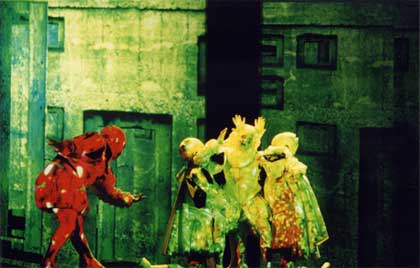
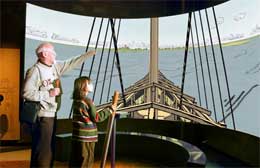 Developed for the Deutsch Technik Museum Berlin, Die Segelanweisung is a Location Based installation which provides an impression of 16th Century sail traffic instructions based on regulations recorded in 1558 by Cornelis Anthonisz.
Developed for the Deutsch Technik Museum Berlin, Die Segelanweisung is a Location Based installation which provides an impression of 16th Century sail traffic instructions based on regulations recorded in 1558 by Cornelis Anthonisz.
Standing in front of a 180°–projection visitors follow the instructions of the captain, bringing the virtual ship upstream to Hamburg. Steering is done by means of the tiller, a mechanism common to the rudders of 16th and 17th Century ships. The tiller responds to the movements of ship and current through physical force feedback and gives the visitor a realistic sensation of steering a ship.
For an exhibition which took place in the Belvedere Palace in Vienna, and which traced the changing face of Austrian history and artistic developments during the 20th century, ART+COM developed The New Austria.
A central element of the exhibition was the “flag trail”, a 250 metre long banner which passed through all the exhibition rooms. As well as conveying information, it also acted as an interface for audiovisual media and enabled visitors to take an active part in the exhibition: they could view slides through a lens, press the keys of a computer quiz to take part in a history quiz game, use an ear trumpet to actually listen in on history or expand key terms by means of touch-sensitive interfaces.
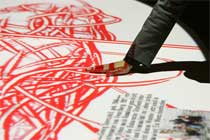

For the The Science of Aliens at the London Science Museum, ART+COM created an interactive room where visitors can get in touch directly with aliens. The creatures move through virtual landscapes and are generated in real time. Visitors can not only watch the aliens but also influence their behaviour and actions. That’s what interested the designers most: how generative systems can create narratives.
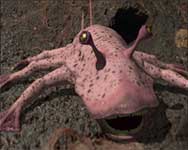
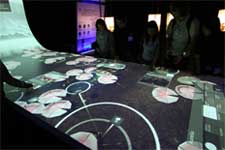 Floating Numbers was the starting point of their exploration of sensitive interfaces. Rules programmed into the system created a space of possibilities that were always evolving. The installation was “well-behaved” in the sense that it didn’t create any frustration when used by visitors. But something they haden’t expected happened: people were scooping the letters in their hands.
Floating Numbers was the starting point of their exploration of sensitive interfaces. Rules programmed into the system created a space of possibilities that were always evolving. The installation was “well-behaved” in the sense that it didn’t create any frustration when used by visitors. But something they haden’t expected happened: people were scooping the letters in their hands.
Dennis and Patrick then took a closer look at behavior and explained what they meant by “well-behaved”.
A brick has no behavior. A dog has. Looking at relationships with domestic animals: domestic animals have to be kept at home and fulfill clear function (they are used to provide food, clothing, etc.) Animals can also fulfill almost emotional functions, they become pets. A qualitative shift from function to affection then takes place. Why? Because a communication is taking place. It leads to a lifelong relationship: you don’t throw your cat away because it is too old to “function” properly. Some owners also project specific ideals and moral views on their pets (See lovely Crouton which was given some human attributes like a haircut; the rainbow manifests the projection of ideas). On some aspects, pets are useless and have more instinct than intelligence.
Several digital artefacts imply some of these mechanisms:
1. Robotic pets (AIBO)
2. Outerspace project by Andre Stubbe and Markus Lerner. Abstraction of living behavior is copied by an artefact. Creates a context which would not exist without behavior.
3. Living with Things, by Monika Hoinkis. These objects can function only with the help of humans.
4. The Sims. Episode when even people went in flames by accident. It was decided that it wasn’t a bug in the game system but a feature that puts the games on a higher level of experience.

 The Subjectified Object Series-Living With Things
The Subjectified Object Series-Living With Things
Conclusion: Digital artefacts “behave”. Even if you don’t think about it, it might happen by accident. We don’t need simple interaction design, we need interesting interaction design and that’s the real challenge. Design ambiguous artefacts and let the negociation take place between the object and the user. Leave space for imagination so that things can happen beyond what can be expected.
Images from Dennis and Patrick’s talk.
